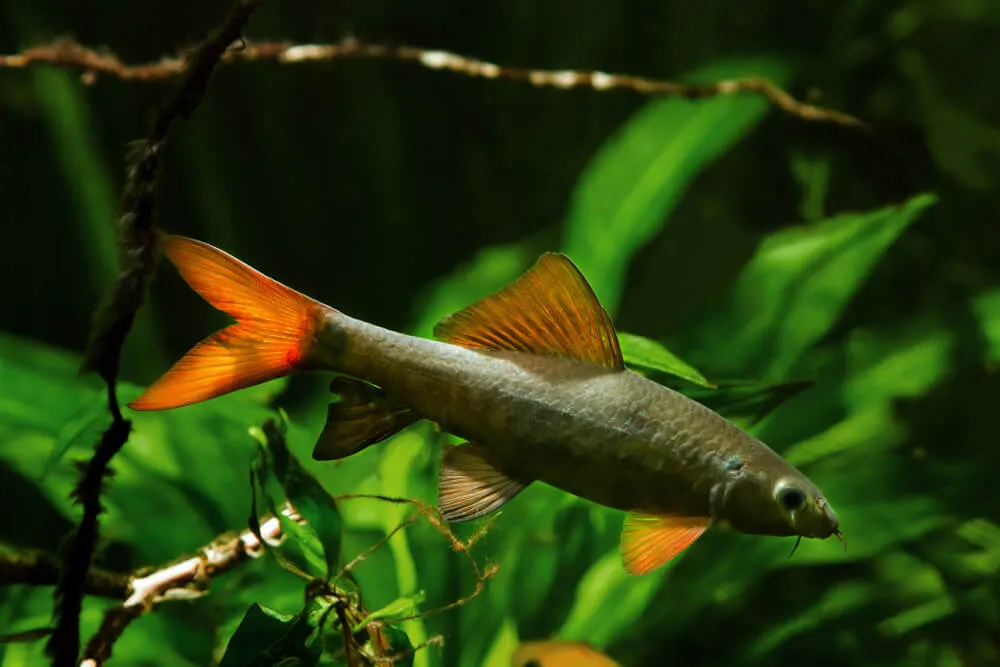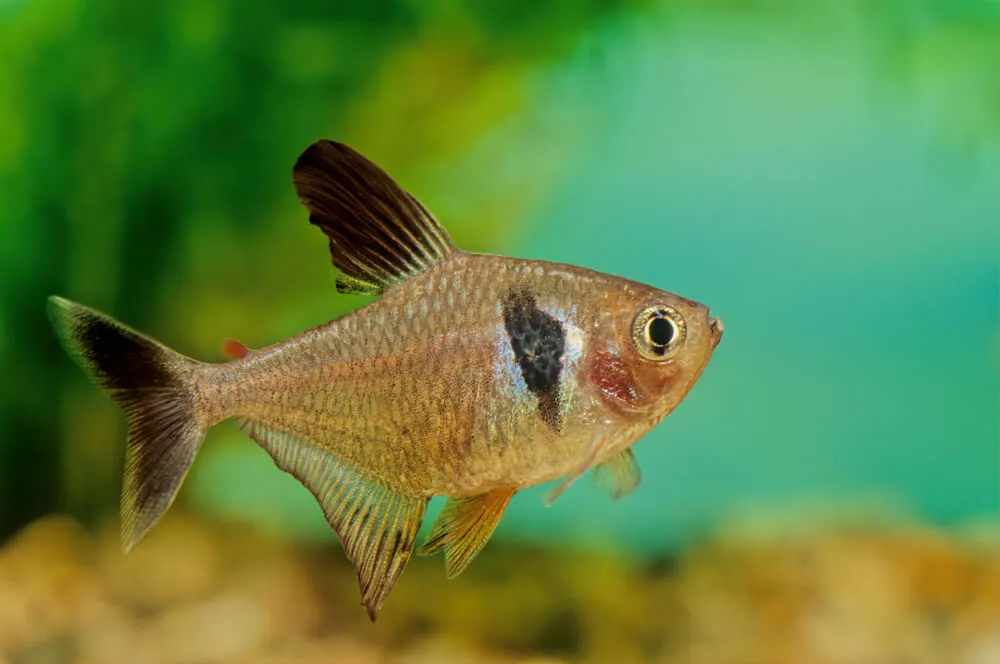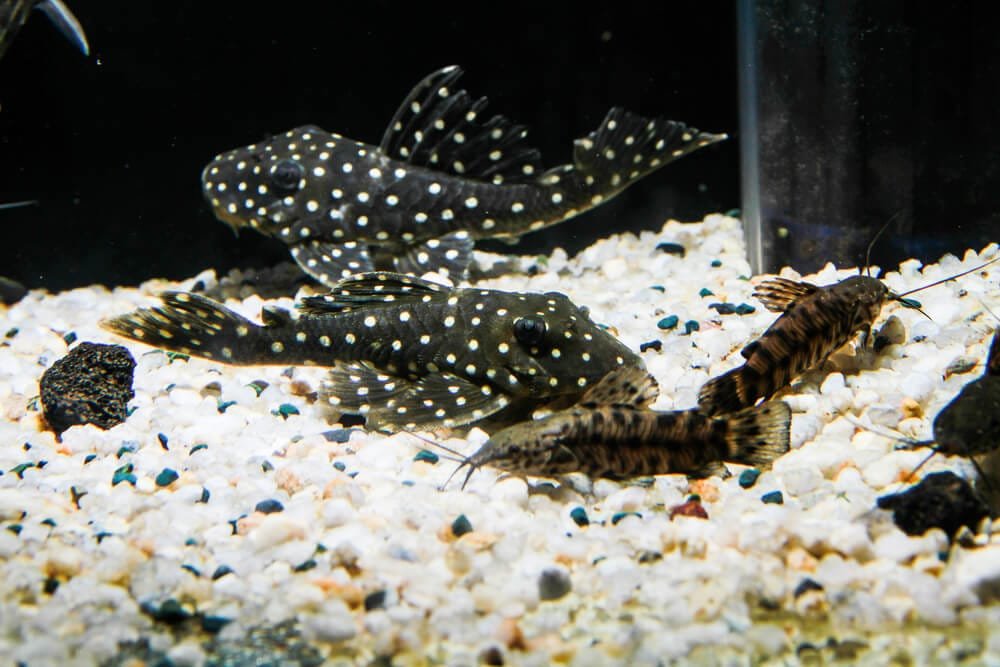Rainbow Shark: Tank Requirements and Behavior Insights

In the colorful world of aquatic creatures, few are as captivating as the Rainbow Shark. Known for their vibrant hues and sleek appearance, Rainbow Sharks add a touch of brilliance to any aquarium. With their black bodies adorned with vivid red or orange fins, these beautiful fish are undoubtedly a sight to behold. Not only are they visually striking, but Rainbow Sharks are also known to be friendly and sociable creatures, making them a fantastic addition to any fish enthusiast’s collection. Whether you’re a seasoned hobbyist or just starting out, the Rainbow Shark is sure to bring a burst of color and charm to your underwater oasis.
Physical Description
The Rainbow Shark, also known as the Red-Finned Shark or Ruby Shark, is a beautiful and eye-catching fish that can add a splash of color to any aquarium. It is a relatively small species, typically reaching around 6 inches in length when fully grown. This size makes it suitable for most home aquariums.
In terms of coloration, the Rainbow Shark lives up to its name. It has a dark black body with vibrant red fins that really stand out. The contrast between the black body and the bright red fins is truly stunning and is one of the main reasons why this fish is so popular among aquarists.
In addition to its striking appearance, the Rainbow Shark has a sleek and streamlined body shape. It has a slightly arched back and a pointed snout, which gives it a predatory and agile look. These physical attributes make the Rainbow Shark a fast and efficient swimmer, capable of darting around the tank with ease.
Natural Habitat
The Rainbow Shark originates from Southeast Asia, specifically from the rivers and streams of Thailand and Malaysia. In the wild, it can be found in both freshwater and brackish water environments. It is a hardy species that has adapted to survive in various conditions.
Geographically, the Rainbow Shark can be found in different parts of the world due to its popularity in the aquarium trade. It has been successfully bred and introduced to different regions, including North America and Europe. However, its natural habitat remains primarily in Southeast Asia.
When it comes to its preferred environment, the Rainbow Shark thrives in tanks with clean and well-oxygenated water. It prefers a temperature range of 72°F to 82°F and a pH level of 6.5 to 7.5. It is important to provide them with plenty of hiding places such as rocks, caves, and plants to mimic their natural habitat.
Tank Requirements
To ensure the well-being of your Rainbow Shark, it is essential to provide it with the right tank size and water parameters. Here are the key considerations:
Tank Size
For a single Rainbow Shark, a tank with a capacity of at least 30 gallons is recommended. However, if you plan on keeping multiple Rainbow Sharks or other tankmates, a larger tank is necessary to minimize territorial aggression.
Water Parameters
Maintaining stable water conditions is crucial for the health of your Rainbow Shark. The ideal temperature range is between 72°F and 82°F, and the pH level should be around 6.5 to 7.5. Additionally, it is important to ensure good filtration and regular water testing to prevent any water quality issues.
Aquascape
Creating a suitable aquascape for your Rainbow Shark will not only enhance their well-being but also create a visually appealing tank. Provide plenty of hiding spots using rocks, caves, and plants. The Rainbow Shark appreciates the presence of driftwood, which can also help recreate its natural habitat. Ensure there is enough open swimming space for this active fish.
Behavior
The Rainbow Shark is known for its territorial and occasionally aggressive behavior. Understanding its behavior can influence tank setup and the choice of tankmates:
Aggression
Rainbow Sharks can display aggression towards members of their own species and other bottom-dwelling fish. They can become territorial as they mature, especially in crowded tanks or if they feel their territory is being invaded. It is best to provide plenty of hiding places and space to minimize aggression.
Compatibility
When it comes to tankmates, it’s important to choose fish that can withstand the Rainbow Shark’s potentially aggressive behavior. Avoid smaller, slow-moving fish and those that inhabit the same area of the tank, such as bottom-dwelling species. Good tankmates include larger and more active species, such as barbs, danios, and larger Tetras.
Territoriality
Rainbow Sharks are highly territorial and may claim areas of the tank as their own. They often defend these territories and may chase away intruders. Providing ample hiding spaces and creating distinct territories within the tank can help minimize territorial disputes.
Activity Level
The Rainbow Shark is an active and energetic fish that spends most of its time exploring its surroundings. It is constantly on the move and requires plenty of space to swim. Observing its active nature can be highly entertaining and enjoyable for aquarium enthusiasts.
Diet
The Rainbow Shark is an omnivorous species, which means it consumes both plant matter and meaty foods. Their diet in the wild consists of algae, small insects, crustaceans, and occasional plant matter. To ensure their nutritional needs are met in captivity, it’s important to provide a balanced diet:
Omnivorous Nature
The Rainbow Shark’s omnivorous nature allows for a varied diet. They readily consume high-quality flakes or pellets specifically formulated for bottom-dwelling fish. Supplementing their diet with occasional live or frozen foods like bloodworms, brine shrimp, and daphnia can help provide essential nutrients.
Feeding Schedule
Offering small portions of food two to three times a day is recommended for Rainbow Sharks. This feeding schedule ensures they receive enough sustenance without overeating. It’s important to observe their feeding habits and adjust the amount accordingly to prevent waste and maintain water quality.
Food Types
To cater to their omnivorous nature, include a mix of dry and live/frozen foods in their diet. High-quality flake or pellet foods should form the base of their diet, supplemented with occasional live or frozen foods, as mentioned earlier. Additionally, providing some vegetable matter, such as blanched spinach or algae-based wafers, is beneficial.
Breeding
Breeding Rainbow Sharks in captivity can be a rewarding experience, although it can be challenging to replicate their natural breeding conditions. Here are some key aspects to consider:
Sexual Dimorphism
Determining the gender of a Rainbow Shark can be difficult, as there are no significant physical differences between males and females. Sexual maturity is often the best indicator, with males exhibiting more territorial behavior and intense coloration during breeding.
Breeding Environment
To encourage breeding, create an environment that mimics their natural habitat. This can include providing multiple hiding spots, areas with low lighting, and a slightly higher water temperature. Regular water changes and maintaining optimal water quality are crucial.
Egg Laying and Care
Rainbow Sharks are egg layers, with breeding pairs engaging in a courtship behavior before spawning. The female will attach the eggs to various surfaces, while the male guards the area. Once the eggs hatch, the parents may consume the fry, so it is recommended to remove the parents from the breeding tank.
Reproductive Behavior
During the breeding period, the male will become more territorial, displaying intense coloration, and chasing away potential threats. The female will lay eggs on various surfaces, such as rocks or plants, and the male will guard the territory until the eggs hatch.
Common Health Issues
While the Rainbow Shark is generally a hardy species, there are a few common health issues to watch out for:
Ich (White Spot Disease)
Ich is a parasitic infection characterized by the appearance of small white spots on the fish’s body. It can be caused by stress or poor water conditions. Treating ich typically involves raising the water temperature and using medication specifically designed to eliminate the parasite.
Fin Rot
Fin Rot is a bacterial infection that affects the fins and can lead to deterioration if left untreated. It is often caused by poor water quality, injuries, or stress. Regular water changes, maintaining proper water parameters, and treating with appropriate medications are necessary to combat fin rot.
Parasitic Infections
Rainbow Sharks are susceptible to various parasitic infections, such as flukes or anchor worms. These pests can cause irritation, scratching, and discoloration in affected fish. Treating parasitic infections often requires medicated baths or treating the entire tank with appropriate medications.
Stress-Related Conditions
Stress can weaken the immune system of Rainbow Sharks, making them more susceptible to disease. Ensuring a stress-free environment with proper tank conditions, compatible tankmates, and a balanced diet can help minimize stress-related conditions.
Tankmates
Choosing suitable tankmates is crucial to maintain a harmonious aquarium environment. Here are some considerations when selecting tankmates for Rainbow Sharks:
Fish
When choosing tankmates, it is essential to consider the size and activity level of other fish. Avoid smaller and slow-moving species that could be seen as easy prey. Opt for larger and more active fish, such as barbs, danios, or larger Tetras, as they are more likely to coexist peacefully with the Rainbow Shark.
Invertebrates
Invertebrates such as shrimp and snails can make suitable tankmates for Rainbow Sharks. However, caution should be exercised when introducing them. Some Rainbow Sharks may display aggressive behavior towards invertebrates, perceiving them as food or competition. Monitor their interactions closely and be prepared to remove invertebrates if necessary.
Avoidance
It is important to avoid keeping multiple Rainbow Sharks in the same tank, as they can become aggressive towards each other in confined spaces. Additionally, avoiding species that inhabit the same area of the tank, such as bottom-dwelling fish, can help prevent territorial conflicts and aggression.
Aquarium Tips
Maintaining a healthy and vibrant aquarium is crucial for the well-being of your Rainbow Shark. Here are some helpful tips to enhance your aquarium experience:
Tank Maintenance
Regular tank maintenance is essential for the health of your Rainbow Shark and the overall well-being of the aquarium. This includes regular water changes, cleaning the filter, and monitoring water parameters. It’s also important to vacuum the substrate to remove any waste or debris.
Decorations
Creating a visually appealing and engaging environment for your Rainbow Shark is important. Incorporating natural decorations such as rocks, caves, and driftwood can provide hiding places and territorial boundaries. Live plants can also be added, as they not only enhance the aesthetics but also contribute to water quality through natural filtration.
Companionship
While Rainbow Sharks are territorial, they can also benefit from companionship. Adding a variety of fish species that coexist peacefully with the Rainbow Shark can create a more dynamic and interesting tank environment. However, always consider the compatibility and space requirements of the tankmates.
Fun Fact
Did you know that there is a non-aquatic Rainbow Shark? While it may share the same name, the non-aquatic Rainbow Shark is actually a land-dwelling reptile. It belongs to the genus Episcopus and is commonly known as a “Rainbow Lizard.” This fun fact highlights the importance of distinguishing between species and understanding their unique characteristics.
Another interesting fact about Rainbow Sharks is that their colors can darken the older they get. While young Rainbow Sharks have vibrant red fins, as they age, their fins may darken to a deep red or even a blackish hue. This color change can be influenced by various factors, including genetics and environmental conditions, adding yet another aspect to the fascinating nature of these fish.






